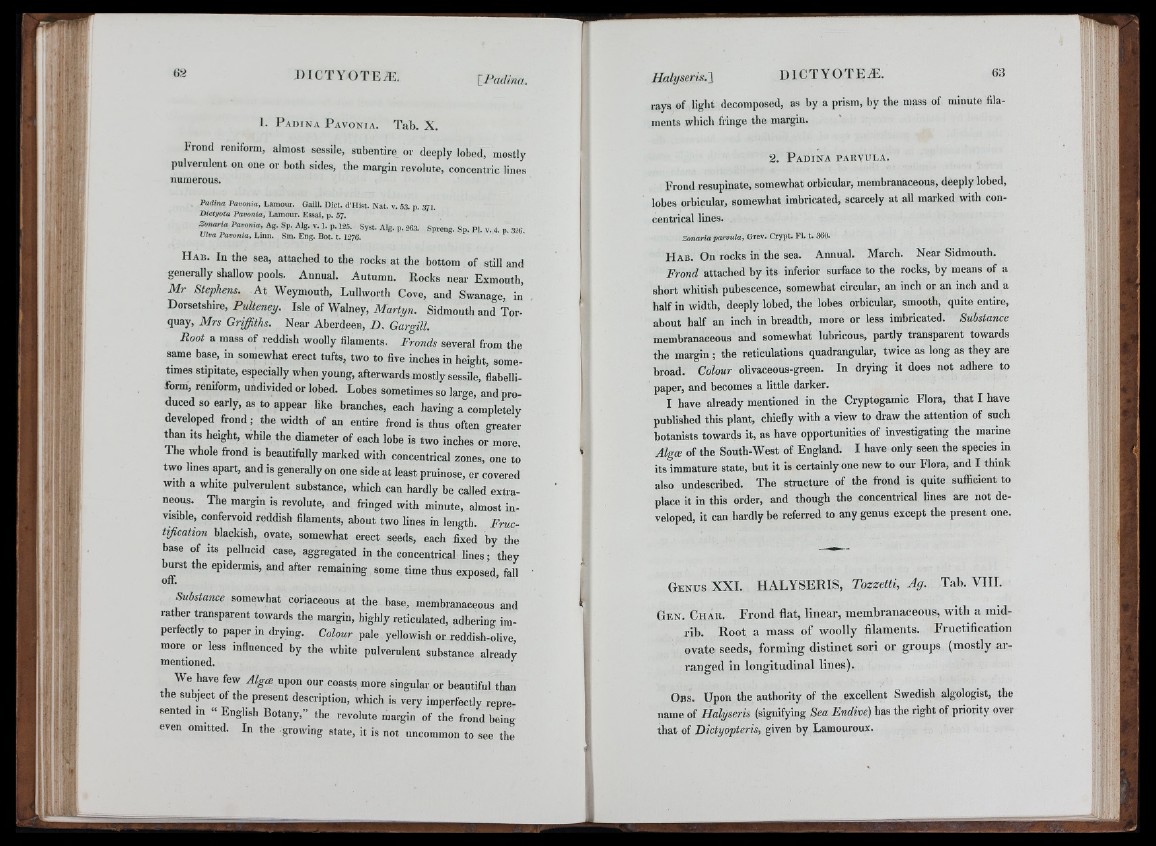
1. P.VDiNA P a v o n ia . Tab. X.
Froud reniform, almost sessile, subentire or deeply lobed, mostly
pulverulent on one or both sides, the margin revolute, concentric lines
numerous.
Padina Pavonia, L am o u r . G a ill. D i e t . d ’H i s t . N a t . v . 53. p . 371.
Dictyota Pavoiiia, L am o u r . E s s a i, p . 57.
Sojmria Pavonia. Ag. S p . A lg . v . 1. p . 125. .Syst. A lg . p . 26.3. S p r e n g . S p . P I . v . 4. p . ,3>e.
Ulva Pavonia, L in n . S m . E n g . B o t. t . 1276*.
H a b . In the sea, attached to the rocks at the bottom of still and
generally shallow pools. Annual. Autumn. Rocks near Exmouth,
Mr Stephens. At Weymouth, Lullworth Cove, and Swanage, in’
Dorsetshire, Pulteney. Isle of Walney, Martyn. Sidmouth and Torquay,
Mrs Griffiths. Near Aberdeen, D. Gargill.
Root a mass of reddish woolly filaments. Fronds several from tlie
same base, in somewhat erect tufts, two to five inches in height, sometimes
stipitate, especially when young, afterwards mostly sessile, flabelliform,
reniform, undivided or lobed. Lobes sometimes so large, and produced
so early, as to appear like branches, each having a completely
developed frond; the width of an entire fiond is thus often greater
than its height, while the diameter of each lobe is two inches or more.
The whole frond is beautifully marked with concentrical zones, one to
two lines apart, and is generally on one side at least pruinose, or covered
with a white pulverulent substance, which can hardly be called extraneous.
The margin is levolute, and fringed with minute, almost invisible,
confervoid reddish filaments, about two lines in length. Fructification^
blackish, ovate, somewhat erect seeds, each fixed by the
base of its pellucid case, aggregated in the concentrical lines; they
buret the epidermis, and after remaining some time thus exposed, fall
Substance somewhat coriaceous at the base, membranaceous and
rather transparent towards the margin, highly reticulated, adhering imperfectly
to paper in drying. Colour pale yellowish or reddish-olive
more or less influenced by the white pulverulent substance alreadv
mentioned. ^
We have few Alga upon our coasts more singular or beautiful than
t e subject of the present description, which is very imperfectly represented
in “ English Botany,” the levolute margin of the frond beinn
even omitted. In the growing state, it is not uncommon to see the
rays of light decomposed, as by a prism, by the mass of minute filaments
which fringe the margin.
2. P a d in a p a r v u l a .
Frond resupinate, somewhat orbicular, membranaceous, deeply lobed,
lobes orbicular, somewhat imbricated, scarcely at all marked with con-
centrical lines.
Zonaria parvula, G r e v . C r y p t . F I . t . 360.
H a b . On rocks in the sea. Annual. March. Near Sidmouth.
Frond attached by its inferior surface to the rocks, by means of a
short whitish pubescence, somewhat circular, an inch or an inch and a
half in width, deeply lobed, the lobes orbicular, smooth, quite entire,
about half an inch in breadth, more or less imbricated. Substance
membranaceous and somewhat lubricous, partly transparent towards
the margin ; the reticulations quadrangular, twice as long as they are
broad. Colour olivaceous-green. In drying it does not adhere to
paper, and becomes a little darker.
I have already mentioned in the Cryptogamic Flora, that I have
published this plant, chiefly with a view to draw the attention of such
botanists towards it, as have opportunities of investigating the marine
Algce of the South-West of England. I have only seen the species in
its immature state, but it is certainly one new to our Flora, and I think
also undescribed. The structure of the frond is quite sufficient to
place it in this order, and though the concentrical lines are not developed,
it can hardly be referred to any genus except the present one.
G e n u s X X I. HALYSERIS, Tozzetti, Ag. Tab. VIII.
G e n . C h a r . Frond flat, linear, membranaceous, witb a midrib.
Root a mass of woolly filaments. Fructification
ovate seeds, forming distinct sori or gi'oups (mostly a rranged
in longitudinal lines).
O bs. Upon the authority of the excellent Swedish algologist, the
name of Halyseris (signifying Sea Endive) has the right of priority over
that of Dictyopteris, given by Lamouroux.